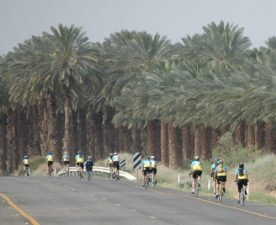 You may not believe it, but the green stuff many people have growing as a decorative plant in their garden may become one of main fibers for manufacturing clothing, linens, curtains, and other fabrics that are presently being made from cotton (a very wasteful pant), and various synthetic fibers.
You may not believe it, but the green stuff many people have growing as a decorative plant in their garden may become one of main fibers for manufacturing clothing, linens, curtains, and other fabrics that are presently being made from cotton (a very wasteful pant), and various synthetic fibers.
Presently a number of fashion designers and manufacturers are becoming interested in this plant –– bamboo –– that can grow in many types of climates and needs little or no attention. And some Muslim women’s clothing sites like ArtiZara already think bamboo-based head coverings are a good idea.
Green Prophet thinks it is an interesting plant for farmers in the region to cultivate since it can easily be grown in places like the Hula Valley in Israel, marshy areas of southern Iraq, along the Nile river in Egypt and Sudan, and other places as well.
All the positive environmental aspects of the plant itself will obviously be beneficial, and even clothing like the chador, khimar, jilbab or kameez garments Muslim women wear. See an example here from ArtiZara.
And since bamboo is so easy to grow, it can be profitable for poorer farmers, especially those in Egypt and Iraq. Read our latest post on the environmental destruction in Iraq’s marshes here.
Bamboo is actually a type of grass, coming from the biological family poaceae. Although usually found in tropical and sub-tropical regions, it is also found in certain parts of the USA, and as far south as Chile.
Some types of bamboo grow as fast as a meter per day in tropical areas. An extremely environmental friendly plant (they absorb about 5 times the amount of carbon dioxide, a primary greenhouse gas, and produces about 35% more oxygen than an equivalent stand of trees), bamboo has been used for centuries for making a number items, ranging from baskets and other utility items, curtains, sleeping mats, paper (used in China for centuries) and even for food.
It’s only been more recently that bamboo fiber and cellulose has become some much in demand, that a number of clothing manufacturers are giving it increased attention.
Some of these include Linda Loudermilk and Kate O’Connor, who use Bamboo fabric as a replacement for silk, rayon and other fabrics.
After processing, bamboo fabric is found to be as soft and “flowing” as silk and cashmere, and is obviously preferable to many people as no animals or animal products are used in its manufacture.
While the plant itself is an ecological wonder, there are some elements in the processing of various parts of the bamboo plant that should be noted, however.
There are basically two ways to process the plant: mechanically or chemically.
Mechanical processing involves crushing the bamboo stalks and using natural enzymes to break down the fiber into a pliable substance from which the fibers can be combed out and spun into yarn.
Chemical processing is much more questionable, from an environmental standpoint; as it involves using a number of chemicals and solvents such as sodium hydroxide (also known as caustic soda) and carbon disulfide, both of which can cause serious health problems.
Taking this into overall consideration, using bamboo fiber over petroleum based ones, fibers made from animal products, or even cotton (which requires a lot of water, fertilizers and human attention) using bamboo for making clothing and other fabrics will become more prominent as newer, more eco-friendly manufacturing technologies are utilized; such as the “lyocell process” which uses N-methylmorpholine-N-oxide to dissolve the bamboo cellulose into a viscose solution.
Known as “week alkaloids” these chemicals are more environmentally friendly than those such as sodium hydroxide.
Besides having an amazing softness, processed bamboo fabrics have a number of environmental and health benefits. They are 100% biodegradable, and are hypo-allergenic, making them wonderful for people allergic to wool and other animal fibers. The bamboo plant itself does not need chemical fertilizers; and by using photosynthesis, helps reduce carbon dioxide levels.
The plant’s extensive root system also helps hold soil together, preventing soil erosion.
Sounds like a win-win-win-win situation, despite any drawbacks from chemical processing. So who’s going to start up the first big plantation in the Middle East for clothing and fair trade jobs?
More on bamboo:
Israeli Designers (And Daniel Fintzi) Do it. Why Don’t You?
Israeli Sabras Do Bamboo Playfully in Kids Toys
Designing Computers With Bamboo




obviously like your website but you have to check the spelling on several of
your posts. Many of them are rife with spelling problems and I to find it very troublesome to inform the reality however I will definitely come back again.
The idea of this Bamboo hijab is amazing. And its good to see that online stores like Artizara are adopting such environment friendly ideas.
i never hear about this Bamboo hijab before.
i never hear about this Bamboo hijab before.
i never hear about this Bamboo hijab before.
Hijab is beautiful. i love it.
Even the “environmentally friendly” version of the chemical process is heavily dependent on petrochemical derivatives that use large amounts of heat energy in their manufacture. Slower, more expensive, mechanical methods seem best.
I am a proud Hijabi muslim.